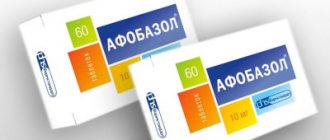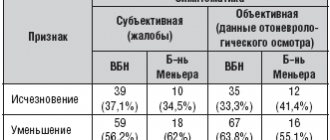Azafen
Azafen (pipofezin) is a drug from the group of tricyclic antidepressants. Prescribed for mild to moderate depression. This is an original drug developed in the USSR in the 60s of the last century. Introduced into medical practice in 1970. In 1996, the drug was discontinued due to the lack of pharmaceutical raw materials for its production, but in 2005 Azafen reappeared on pharmacy shelves. The effect of the drug is based on its ability to increase the level of serotonin and norepinephrine in the central nervous system. Among other tricyclic antidepressants, the drug stands out due to its lack of toxic effect on the heart and anticholinergic activity. Azafen also has a moderate sedative effect. The effectiveness of the drug has been confirmed in several clinical trials. In patients with mild to moderate depression, Azafen showed a uniform reduction in the severity of symptoms of affective disorders. In half of the study participants, the symptoms were completely relieved; in the rest, the clinical picture was noticeably smoothed out. Experience with Azafen shows that when using the drug, mood improvement is observed most quickly, then anxiety symptoms (anxiolytic component) are eliminated, and lethargy is eliminated a little more slowly. Thus, the sedative and anxiolytic effects of the drug are somewhat ahead of its antidepressant effect. Complete elimination of inhibition of thinking and speech, as well as restoration of previous motor activity, is observed after a month of drug therapy. Azafen has demonstrated its effectiveness in depression of alcohol origin, both after abstinence and at the stage of remission.
The drug eliminates the craving for alcohol, reduces the risk of developing behavioral disorders, and improves mood. Azafen is also used for depression caused by somatic pathologies, incl. cardiovascular and gastrointestinal diseases, menopausal syndrome. Azafen has a favorable safety profile. Undesirable side reactions (weakness, drowsiness, absent-mindedness, slight increase in heart rate, hyposalivation, headache) are, as a rule, mild in severity and, when taking the drug in a daily dose of 100–200 mg, develop only in every fifth case. Pipofezin is quickly and completely absorbed from the gastrointestinal tract. Peak concentration in the blood is reached 2 hours after administration. Half-life is 16 hours. Excreted from the body mainly with urine. Azafen is contraindicated in persons with individual intolerance to pipofezin, severe liver and kidney diseases, during pregnancy and breastfeeding. The frequency of use of the drug is 2 times a day (after waking up in the morning and at lunchtime). If the drug is well tolerated, it is taken 3-4 times a day, with the last dose before going to bed. When control of the symptoms of the disease is achieved, the dose is reduced (so-called maintenance therapy). The duration of the medication course is at least one month. The maximum duration is up to one year. Taking Azafen is incompatible with drinking alcohol. During the medication course, you should refrain from engaging in potentially hazardous activities that require attention and concentration, incl. driving a car.
Azafen (pipofesin) – return to clinical practice
Over the past years, the number of antidepressants presented on the Russian pharmaceutical market has increased significantly, as well as the frequency of their prescription by both psychiatrists and doctors of other specialties. Indications for the use of thymoleptics are very wide - in addition to depression itself, they also include a number of disorders in the structure of which affective symptoms are not dominant. This is primarily a group of anxiety and panic disorders, obsessive-compulsive disorders and phobias, neurasthenia, anorexia nervosa and bulimia, post-traumatic stress disorders and adaptation disorders, a wide range of personality and somatoform disorders. On the threshold of the 21st century, there is a more and more clearly visible tendency for the scope of antidepressants to go beyond the boundaries of affective pathology, but also beyond the psychiatric field. A characteristic feature of the modern pathomorphosis of various painful manifestations is the high proportion of neurotic and somatoform disorders and the appearance of “mental masks” of internal diseases. As a consequence of this, there is an overlap between the areas of activity of psychiatrists and specialists in other medical disciplines. Large-scale multicenter studies conducted by psychiatrists together with doctors of other specialties reveal the presence of mental disorders requiring medical correction with antidepressants in up to 57% of general practitioners. Moreover, in 75% of cases, treatment of concomitant mental disorders in somatic hospitals can be carried out by a general practitioner, in 20% - by him, but with the close participation of a psychiatrist, and in 5% there is a need for transfer to a psychosomatic department [5]. Research data indicate the need to include antidepressants in therapeutic regimens for the treatment of chronic tension headaches, abuse headaches, autonomic dystonia syndrome, fibromyalgia, diseases of the cardiovascular and respiratory systems, and the gastrointestinal tract [3]. An indispensable guarantee of successful treatment of the listed disorders is the principle of an integrated approach, which includes, along with full-fledged pharmacotherapy, a wide range of psychotherapeutic, physiotherapeutic and social rehabilitation measures. However, a key role in achieving and stabilizing high effectiveness of treatment is played by adequate prescription of antidepressant therapy, the use of which would provide stable compensation for painful manifestations without causing significant side effects. The current stage of development of psychopharmacotherapy is characterized by the active introduction of a large number of new antidepressants - both original and generics, produced mainly by Western pharmaceutical companies. The selectivity of psychopharmacological effects, or “precision of the site of application” and, as a consequence of this, a good tolerability profile with a sufficient level of effectiveness have allowed the latest generations of psychopharmaceuticals to steadily occupy a fairly wide niche in the structure of the total consumption of antidepressants by patients. However, the high cost of imported medicines makes them inaccessible to most patients, many of whom have low incomes. Alas, despite the high selectivity of action, almost all modern antidepressants are also not without side effects. Nausea, dizziness, decreased potency - this is not a complete list of adverse effects of therapy, for example, selective serotonin reuptake inhibitors. In this regard, the “rebirth” of the original domestic antidepressant Azafen (pipofezin) seems very timely and in demand. Its production was resumed by the Russian one, the production of which was designed and built in accordance with Russian and international GMP standards. Azafen was synthesized as a “small” antidepressant, combining moderate thymoanaleptic and sedative effects, in the 60s of the 20th century by the Center for the Chemistry of Medicines under the direction of M.D. Mashkovsky. Being tricyclic in structure, it had virtually no anticholinergic activity, which predetermined its good tolerability and a minimum of side effects (Fig. 1). Its pharmacological properties included weakening the depressing effect of reserpine, enhancing the action of phenamine and 5-hydroxytryptophan, the absence of an inhibitory effect on MAO, and a combination of thymoleptic action with sedative activity [2]. This spectrum of its psychotropic action predetermined the widespread use of the drug in the treatment of mainly neurotic and neurosis-like disorders. These were mainly affective disorders with irritability, emotional lability, anxiety and asthenia, somatogenic and reactive depression, dysthymia and cyclothymia, minor alcoholic depression, occurring with both anxiety and lethargy. Azafen combined well in combination therapy with neuroleptics, anxiolytics and hypnotics. In the 70–80s of the 20th century, the overwhelming number of patients at the Moscow Neurosis Clinic who had indications for antidepressant therapy were prescribed Azafen [6]. Subsequently, due to the crisis in the domestic pharmaceutical industry, its production was discontinued and it disappeared from clinical practice. Nevertheless, over the years, at symposiums and conferences devoted to the treatment of borderline mental disorders, many speakers nostalgically remembered the drug with kind words and regretted its absence. And even when its release was discontinued, Azafen remained on the pages of reference books and monographs as the drug of choice for the treatment of affective pathology [1, 4]. Currently, the production of Azafen has been established, it has passed the necessary registration procedures and is available for purchase in the pharmacy chain. To determine the effectiveness, safety and tolerability of Azafen in patients with borderline forms of mental disorders, as well as to determine the possibilities of its use as monotherapy or in combination with psychopharmaceuticals of other groups in SKB No. 8 named after. Z.P. Solovyova - “Clinic of Neuroses” conducted an open non-comparative study. 50 patients were examined, 40 of whom received inpatient treatment, and 10 were treated as a day hospital (Table 1). The criteria for inclusion of patients in the study were: 1) the presence of borderline mental pathology without psychotic symptoms; 2) informed consent; 3) cancellation of previous therapy at least 48 hours in advance; 4) age from 18 to 65 years; 5) at least 11 points on the Hamilton Rating Scale and at least 3 on the CGI-S scale. The exclusion criteria were as follows: 1) a history of individual intolerance to the drug or an allergic reaction to Azafen; 2) a significant decrease in quality of life due to the effect of the drug; 3) the presence of chronic somatic diseases in patients, including residual organic symptoms due to vascular diseases, traumatic brain injuries, involution, alcoholism, etc.; 4) high probability of non-compliance. Among the patients studied, there were 10 men and 40 women, the average duration of the disease was 1.5 years. Before treatment, the condition of all patients was assessed as moderate. The duration of active therapy was 42 days, the “Wash out” period was 48 hours. All patients completely completed treatment. The effectiveness of therapy was assessed using the Hamilton Depression Scale (HAMD) and Clinical Global Assessment (CGI) on days 0, 7, 14, 21 and 42 of treatment. Azafen was prescribed at a dose of 75 mg/day, followed by an increase in the absence of a positive effect by day 7 to 150 mg/day. In cases of severe insomnia, the study protocol allowed the administration of one of the short-lived hypnotics (zolpidem, zopiclone), and in the event of maladaptive anxiety, the use of alprazolam. Tolerability was assessed using the UKU Adverse Event Scale, which includes a description of the adverse event, date of onset, duration, severity (mild, moderate, severe) and relationship to the study drug (possible, probable, clear). Throughout the study, vital functions were monitored - blood pressure and pulse control, general blood and urine tests. During the study, not a single patient dropped out of the study. In all patients, the reduction of symptoms on the Hamilton scale exceeded 50%, i.e. all of them responded to Azafen therapy. The effect was observed already in the first weeks of treatment and then progressively increased. The distinct thymoanaleptic effect of the drug is emphasized by the fact that almost all patients experienced a complete reduction of depressive symptoms (the total score on the Hamilton scale at the end of the study was less than 10) (Fig. 2, 3). These data characterize the speed and completeness of the thymoanaleptic effect of the drug. However, given the open and non-comparative nature of the study, the role of the placebo effect in achieving such high efficacy rates of Azafen cannot be excluded. It is known that the placebo effect in depression varies from 30 to 50% [7]. Nevertheless, it can be stated with a reasonable degree of confidence that the dynamics of reducing the degree of depression and anxiety during Azafen therapy is quite pronounced and indisputable. Azafen was very effective in eliminating sleep disorders associated with depression. Clinically, this was manifested by a gradual increase in the duration and then an increase in the quality of sleep in the absence of a truly hypnotic effect, symptoms of consequences and daytime sleepiness. The antidepressant effect of Azafen was manifested not only by an anxiolytic and some activating components, but also by a harmonious reduction of the entire depressive syndrome, including the somatic symptom complex. Similar dynamics were noted in relation to other symptoms of depression - performance, activity, insomnia, lethargy, hypochondriacal manifestations. At the same time, the drug did not affect somatic characteristics - blood pressure, heart rate, body weight. Of the adverse events, only isolated cases of dry mouth, nausea, and drowsiness were recorded. Moreover, these side effects were quickly reduced by reducing the dosage and in no case led to patients refusing to continue therapy. The drug did not increase anxiety, and also did not exhibit cardiotoxic and anticholinergic effects. During treatment with Azafen, the quality of life of patients significantly improved. At the end of the course of treatment, almost everyone characterized it as “good” or “excellent” (Table 2). It should be noted that such impressive results of the study were to a certain extent predetermined by the selection of patients with an average level of depression. We deliberately avoided prescribing Azafen to patients with severe and treatment-resistant depression. The issue of clarifying the effectiveness of Azafen in such groups of patients is a complex methodological task and requires randomized comparative studies. The main result of this work is the statement of the possibility of effective use of azafen in the treatment of various syndromic forms of depression of moderate severity. Good tolerability of the drug, the transient nature of side effects, the insignificant severity of the latter and the almost complete absence of influence on the condition and functioning of internal organs and systems are important advantages in the treatment of a wide range of patients with depression. Moreover, the above characteristics make it possible to recommend the prescription of azafen both in hospitals and in the community network by both psychiatrists and general practitioners. Based on the results of the study, the following conclusions can be drawn: • Azafen, when used for 6 weeks, provides a significant reduction in affective pathology in patients with neurotic disorders, without causing significant side effects and without affecting the cognitive functions of patients. • The optimal daily dose was 75–150 mg/day. • If there are indications for antidepressant therapy, Azafen can be recommended for widespread use in both inpatient and outpatient settings.
Literature 1. Aleksandrovsky Yu.A., Bardenshtein L.M., Avedisova A.S. Psychopharmacotherapy of borderline mental disorders. // M.: “Geotar-medicine”, 2000. 2. Mashkovsky M.D. Medicines. // M. “Medicine”, 1996, p. 121. 3. Mosolov S.N. Clinical use of modern antidepressants. // St. Petersburg: Medical Information Agency, 1995, p. 133. 4. Psychopharmacological and antiepileptic drugs approved for use in Russia. Ed. Mosolova S.N. 2nd ed.. M, 2004, p. 133. 5. Smulevich A.B. Depression in general medical practice. M., 2000. 6. Shinaev N.N., Dachevskaya I.I., Akzhigitov R.G. Experience in the treatment of borderline mental disorders in the “Clinic of Neuroses”. // Russian Psychiatric Journal. 2000, No. 1, p. 54–58. 7. Brown WA. Predictors of placebo–response in depression. Psychopharmacol Bull 1988; 24: 14–7.
SIDE EFFECTS OF TRANQUILIZERS
(ANTI ANXIETY DRUGS).
Development of addiction and formation of drug dependence
Signs: the first sign of addiction to the drug is the desire to increase the dose of the drug used, since the previous amount of the drug ceases to give the desired effect and no longer relieves unpleasant symptoms. Subsequently, the dependence manifests itself in the inability to “get off” the drug: when trying to stop the drug, a “withdrawal syndrome” occurs: anxiety, low mood, irritability, heaviness in the head, insomnia, severe weakness, loss of appetite, tremors in the hands, palpitations, increased blood pressure . Leg cramps and even grand mal seizures and daytime urinary incontinence may occur.
Drugs that cause addiction and dependence:
Most often: Relanium (Seduxen, Sibazon), lorazepam (Lorafen), alprazolam
Reliably less common: Elenium, clonazepam, tazepam (nozepam)
What to do if you become addicted to the drug? It is very difficult to stop taking a tranquilizer on your own if you have developed an addiction due to the duration of the “withdrawal syndrome” (about three weeks), the gradual increase in symptoms by the end of the first week of abstinence, and the possible development of dangerous complications (epileptic seizures). It is most advisable to reduce the dose of the drug very slowly under the supervision of a doctor who, in addition to observation, will be able to select therapy aimed at accelerating the elimination of the drug from the body and relieving unpleasant and painful symptoms.
Attention! Signs of the formation of drug dependence appear within 1 - 1.5 months after starting to take the above drugs (especially Relanium, Lorafen and Alprazolam). Most often, dependence on tranquilizers occurs during self-medication, so it is strongly NOT recommended to prescribe these drugs to yourself without the participation of a doctor.
Deterioration of memory and attention, impaired coordination of movements, increased effects of alcohol
Signs: These side effects are united by the concept of “behavioral toxicity” of tranquilizers. A person feels less efficient, it is difficult for him to concentrate for a long time, it is difficult for him to think quickly and find answers in a conversation, he may immediately forget the facts that are told to him. There is a feeling of insufficient “inclusion” in the situation. There may be motor clumsiness and lack of coordination of movements.
Drugs that most often cause such symptoms: diazepam, clonazepam, lorazepam, nitrazepam, phenazepam, elenium (Librium), estazolam
Attention! Alcohol intake is prohibited during the treatment period. You should refrain from activities related to operating machinery and vehicles.
Excessive sedation
Signs: drowsiness, lethargy, difficulty waking up in the morning.
Drugs that most often cause these symptoms: flunitrazepam (Rohypnol), nitrazepam (radedorm), clonazepam, phenazepam, lorazepam, diazepam (Relanium, Seduxen)
Muscle relaxation
Signs: general weakness, or weakness in certain muscle groups (for example, in the arms), relaxation in the body, reluctance to move again.
Drugs that most often cause these symptoms: diazepam (Relanium, Seduxen), clonazepam, phenazepam, nitrazepam, lorazepam
Paradoxical reactions
Signs: instead of calming and relieving anxiety, opposite reactions to taking a tranquilizer may occur: increased anxiety, motor restlessness, fussiness, irritability and even aggression. Such reactions are rare and depend on the individual characteristics of the patient’s body.
“Paradoxical” reactions have not yet found definitive confirmation of their connection with the use of certain tranquilizers. However, there is evidence that triazolam, for example, quite often contributes to the appearance of pronounced aggressive behavior. In isolated cases, paradoxical reactions in the form of anxiety and sleep disturbances were noted in patients taking buspirone.
Drugs that do not cause excessive sedation, muscle relaxation and impairment of memory and attention: oxazepam (tazepam, nozepam), grandaxin, stresam, buspirone, atarax, afobazole, mezapam (rudotel), clorazepate.
If you are taking mood stabilizers (mood correctors)
Mood correctors
– drugs that have the ability to influence both pathologically depressed and pathologically elevated mood. The ability to regulate mood is manifested in the elimination of severe affective disorders, and then in the stabilization of mood at a certain average level. Thus, the main indication for prescribing mood stabilizers is the presence of depressive and manic attacks that recur quite often.
Most mood correctors (except lithium) are also anticonvulsants used in the treatment of epilepsy.
In addition, mood stabilizers are successfully used in the treatment of:
- personality disorders accompanied by explosiveness, conflict, irritability, aggression
— depression in patients with alcoholism
- migraine
Normotimics include:
- lithium salts (preparations sedalit, micalit, litosan, contemnol, quilonum retard)
- valproic acid (drugs Depakine, Konvulex, Encorate, Apilepsin, Konvulsofin, Dipromal, Orphyril, Everiden)
- carbamazepine (synonyms: finlepsin, tegretol, actinerval, gene-karpaz, zagretol, zeptol, carbadak, carbalepsin, carbapin, karbasan, carbatol, carzepin-200, mazepin, novo-carbamaz, stazepin, storilat, timonil, finzepin, epial)
SIDE EFFECTS OF NORMOTIMICS.
Side effects of lithium drugs (sedalite, micalite, litosan, etc.)
At the initial stage of preventive therapy with lithium salts, mild side effects may appear in the form of increased fatigue, disorders of the digestive system (nausea, vomiting, diarrhea), and occasional mild hand tremors. At acceptable concentrations of lithium in the blood (within 0.5 - 0.8 mEq/L), these phenomena do not require a dose reduction and usually disappear as the body adapts to the drug.
With a relative duration of treatment (over several months and years), the following may appear:
- diffuse enlargement of the thyroid gland
- noticeable weight gain
- minor swelling
- temporary deterioration in vision clarity.
In these cases, it is sometimes necessary to slightly reduce the dose or switch from using a long-acting (long-acting) drug to taking short-acting drugs in the same dose 2-3 times a day.
The main complication that can occur with long-term use of lithium drugs is intoxication with lithium salts.
Early signs of lithium overdose: increased thirst and trembling fingers. Then lethargy, weakness, and drowsiness appear. Then vomiting and diarrhea occur, swelling increases, speech difficulties and heart rhythm disturbances appear.
At the first signs of intoxication, you must immediately stop taking the drug and consult a psychiatrist, who will prescribe treatment aimed at accelerating the elimination of lithium from the body and relieving symptoms of intoxication.
Provoking factors that increase the concentration of lithium in the blood: a diet with limited salt and liquid, combination with indomethacin, some antibiotics (ampicillin, tetracycline)
Attention! Treatment with lithium preparations is carried out with regular monitoring of the concentration of lithium in the blood plasma:
- in the acute period (treatment aimed at “breaking off” a painful attack): the concentration of lithium in the blood is monitored daily, and it should not exceed 1.2 - 1.4 meq/l
- selection of a daily dose for prophylactic use (treatment is aimed at preventing repeated attacks of depression or manic states) requires determining the concentration of lithium in the blood, first once a week during the first month, then 1 - 2 times a month, after 7 months of therapy - once at 3 – 4 months. The lithium concentration that provides a preventive effect should be in the range of 0.5 – 0.8 mEq/L
Side effects of valproic acid drugs (convulex, depakine, encorate, etc.)
The most common side effects of valproic acid therapy are gastrointestinal disorders: nausea, diarrhea, loss of appetite.
Possible excessive sedative effect in the form of drowsiness, slowing down of thought processes.
Also possible: tremor (shaking of hands), loss of coordination of movements.
When using long-acting drugs used once a day (for example, Depakine Chrono), side effects occur more often, it is possible that appetite may increase rather than decrease, and hair loss is sometimes observed.
To prevent these phenomena, it is advisable to combine valproic acid with a daily intake of multivitamins with a set of microelements, including, in particular, selenium and zinc.
Side effects of carbamazepine (finlepsin, tegretol)
When carrying out carbamazepine therapy, side effects are expressed in headaches, dizziness, loss of coordination of movements, drowsiness, dermatitis or skin itching, sometimes double vision, blurred vision.
As with other mood stabilizers, side effects such as nausea and vomiting are possible.
However, in most cases, carbamazepine is well tolerated, even with long-term use.
If you take nootropics (meals that improve nutrition and brain function)
Nootropics
– medications that stimulate mental activity, improve memory, and accelerate learning processes.
Application: decreased general activity, asthenic conditions of various origins, brain lesions (vascular, traumatic, alcoholic, infectious), conditions after strokes, coma, dementia, in pediatric practice: with intellectual disability, developmental delay, attention deficit hyperactivity disorder (ADHD) ), tics, enuresis.
Noothorps are always used in the treatment of alcoholism.
Effects of nootropics (present in different drugs in different amounts):
— Psychostimulating (increasing the activity of the sphere of impulses) – used in states of decreased activity, inactivity and apathy, intellectual inhibition
— Antiasthenic (reduction of weakness, increased physical and mental exhaustion)
— Increasing the level of wakefulness of consciousness - used in states of depressed or darkened consciousness
— Adaptogenic – increasing the resistance of the body and psyche to various harmful environmental factors, including intoxications
— Nootropic (strengthening the functions of thinking, memory)
— Antiepileptic (for some drugs)
— Antiparkinsonian (used not only for Parkinson’s disease, but also to relieve the unpleasant side effects of antipsychotic therapy - see above)
— Vegetotropic (stabilization of the autonomic nervous system)
Table of synonyms for nootropic drugs.
| International name of the drug | Names of this drug that are found in pharmacies (the most commonly found dosage forms in pharmacy chains are highlighted) |
| Drugs with a predominant stimulating, activating effect (cannot be taken at night as it may impair sleep) | |
| Meclofenoxate | Acefen, Centrophenoxine, Cerutil |
| Phenylpiracetam | Fenotropil |
| Ethylthiobenzimidazole | Bemitil |
| Pyritinol | Encephabol, Pyriditol, Cerebol, Enerball |
| Piracetam | Nootropil, Piracetam, Lucetam, Memotropil, Oykamid, Cerebril, Stamin, Escotropil, Piratropil |
| Piracetam + cinnarizine | Fezam, Combitropil, NooKam, Omaron, Piracezin |
| Piracetam + Vinpocetine | Vinpotropil |
| Deanol aceglumate | Demanol, Noocleril |
| Gamma-aminobutyric acid | Aminalon |
| Glutamic acid | L-Glutamine, Calcium glutamate, Epilapton, Acidogen, Glutan |
| Hexobendine+Etamivan+Etophylline | Instenon |
| Ginkgo biloba | Tanakan, Bilobil, Gikoba, Ginkyo, Memoplant |
| Preparations with balanced action | |
| Methionyl-glutamyl-histidyl-phenylalanyl-prolyl-glycyl-proline | Semax |
| Cerebrolysin | Cerebrolysin |
| Choline alphoscerate | Gliatilin |
| Drugs with a predominant sedative, calming effect | |
| Ethylmethylhydroxypyridine succinate | Mexidol |
| Aminophenylbutyric acid | Phenibut |
| Nicotinoyl gamma-aminobutyric acid | Picamilon |
| Hopantenic acid | Pantogam |
| Sodium hydroxybutyrate | Sodium hydroxybutyrate |
| Glycine | Glycine |
SIDE EFFECTS OF NOOTROPICS
Nootropics are low-toxic drugs and are usually well tolerated by patients.
Side effects may include sleep disturbances and increased irritability. Such effects are inherent in nootropics with a predominant stimulating effect. These include (in descending order of stimulating effect): acephen, phenotropil, bemitil, encephabol, nootropil (piracetam), demanol, aminalon.
On the contrary, drugs with a predominance of a mild sedative (calming) effect do not cause increased irritability, anxiety and sleep disturbances, and even relieve these unpleasant symptoms. Nootropics with a predominant calming effect include phenibut, mexidol, picamilon, pantogam.
Other side effects of nootropics (occur quite rarely, are unstable and pass quickly): headache, nausea, stool disorders, fluctuations in blood pressure





